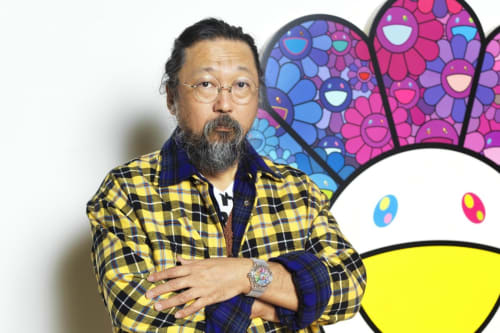“I want my art to break down barriers and challenge conventional notions of what is 'fine art.'”
Takashi Murakami (b. 1962, Tokyo, Japan) is internationally renowned for his bold synthesis of historical Japanese aesthetics and contemporary pop culture. His work navigates the boundary between fine art and mass consumption, collapsing high art and popular culture; the profound and the playful. Murakami earned his BA, MA, and Ph.D. degrees in nihonga–traditional Japanese painting–from Tokyo University of the Arts. He draws on his foundation in historical Japanese art to inform his artistic practice—from compositional flatness to formal conventions. Edo-period masters, such as Hokusai, inspire Murakami's use of linear clarity and vibrant colors.
Murakami is likewise inspired by modern Japanese society and consumer culture. His works adopt the aesthetics of otaku–a youth subculture obsessed with manga, fantasy, and anime. His art evokes both the kawaii (cuteness) and violence of Japan’s media landscape. His signature style combines anime styles with historical sources to mirror the complexity of postwar culture, celebrating and critiquing globalization and Western influence, mining Japan’s past and present.
In 1994, Murakami received a fellowship from the Asian Cultural Council to travel to New York City and participate in the MoMA P.S.1's International Studio Program. Here, he began to employ elements of nihonga, anime, and manga. His visual appropriation of popular media places him in the lineage of Pop artists Roy Lichtenstein and Andy Warhol. In 1996, Murakami opened the Hiropon Factory to produce serial artworks. His factory model shares features with Andy Warhol’s industrialized factory and Edo-period collaborative print workshops. In 2001, the factory became a corporation, Kaikai Kiki, with Murakami increasingly investigating art’s relationship with the art market. Additionally, Murakami uses Kaikai Kiki Co. to foster and highlight the talents of emerging Japanese artists through artistic mentorship and exhibitions.
In 2000, Murakami published his theory of Superflat, which connects Japan’s historical painting styles and its contemporary media and created an art movement in Japan. The concept was first presented in the exhibition Superflat, which Murakami curated. The theory posits a deliberate flattening of pictorial space and hierarchies between art forms. The movement challenges the Western-centric canon and asserts the global relevance of Japanese contemporary art.
Throughout the 2000s, Murakami expanded beyond the traditional gallery space, collaborating with Louis Vuitton, Pharrell Williams, and Kanye West to explore the intersection of luxury and art. His smiling flowers and character Mr. DOB have become widely recognizable global icons.
Following the 2011 Tōhoku earthquake and tsunami, Murakami’s tone shifted. In works of monumental scale and intensity, he invoked motifs from Japanese religion and folklore, grappling with themes of transience. These mature works, often featuring skulls and mythical beasts, suggest a profound reckoning with history and mortality. In the lineage of both Hokusai and Warhol, Takashi Murakami has redefined the possibilities of contemporary art. Through his practice, he bridges epochs and societies, constructing an original vision of 21st-century Japan.
